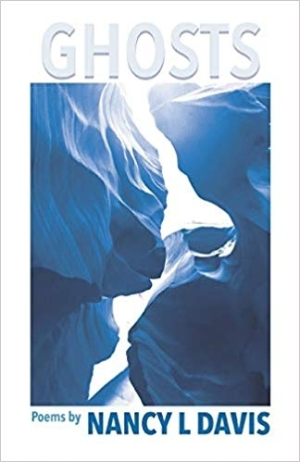Ghosts
Poems by Nancy L. Davis
The poems of Ghosts contain exacting imagery from the natural world, rich language, and a powerful sense of justice.
Nancy L. Davis’s volume of poems, Ghosts, traces the slim boundary between life and death, whether through nature, memorials, or grief. The poems vary in form and style but are consistent in their evocation of nature and its relentless pursuit of life, regardless of humanity’s intentions and blunders.
The book opens with the eerie beauty of “Sanctuary” and its matter-of-fact first lines:
the dead are buried here,
contaminated fish bones compressed into
strata of an unintended geological age;
radioactive skulls the stuff of Dia de los Muertos.
However technicolor and unsettling, nature reclaimed the land around Chernobyl and found a way to thrive, and thus the poem introduces some of the book’s primary themes. “Mating,” in luscious language, riffs on the mating habits of alligators as ancient ancestors, calling them the “consummate survivor,” though the pleasure of the poem is not just in the way that alligators have marked their existence on Earth in tens of thousands of years, but in the lush alliterative language with which they are described: with “lustful Cleopatra eyes / protruding like periscopes” and
floating
in a fount of ecstasy, bubbles
emanating sounds
growling and guttural rippling
in watery effervescence.
After these entries, the book begins to turn, and its ghosts become tragic. They include a beloved pet, a dancer, and hundreds of Jews killed by an SS Mobile Killing Squad. But as in the first poems, it is often the metaphor of nature that allows entrance into scenes. In “Ghosts,” the ground outside of Rawa-Ruska, Ukraine, where so many were killed, becomes figured as an earth mother: “Strange this swath of land / should stretch stillborn in / the fertile season.” It is as if even the earth has been marked by the cruelty of humanity.
The poems move with ease from global griefs to those more family-centered and localized. They call forth details from relationships to show private sorrows, like the shadows on the coat of a loved one, the creak of a door, and a thwarted desire to speak with the dead. Such poignant images show the ghosts that might hover in the doorway, in a slant of afternoon light, or in garden brought to bloom.
The book works across a variety of forms, condensing its work into shapely haiku and sonnets, then expanding toward a protest poem that takes its voice not only from personal rage against injustice in America, but from the words of Langston Hughes and Dudley Randall, folk singers, and American history. Some poems contain the quick sketch details of lyrics, as with “Still Life,” while others have narrative, multiple people points-of-view, including “Desire,” whose central concept changes with each new speaker, including a mother and a bear.
With exacting imagery from the natural world, rich language, and a powerful sense of justice, the poems of Ghosts enlarge the idea of the ghosts that human beings create and become as a result of both carelessness and love.
Reviewed by
Camille-Yvette Welsch
Disclosure: This article is not an endorsement, but a review. The publisher of this book provided free copies of the book and paid a small fee to have their book reviewed by a professional reviewer. Foreword Reviews and Clarion Reviews make no guarantee that the publisher will receive a positive review. Foreword Magazine, Inc. is disclosing this in accordance with the Federal Trade Commission’s 16 CFR, Part 255.

